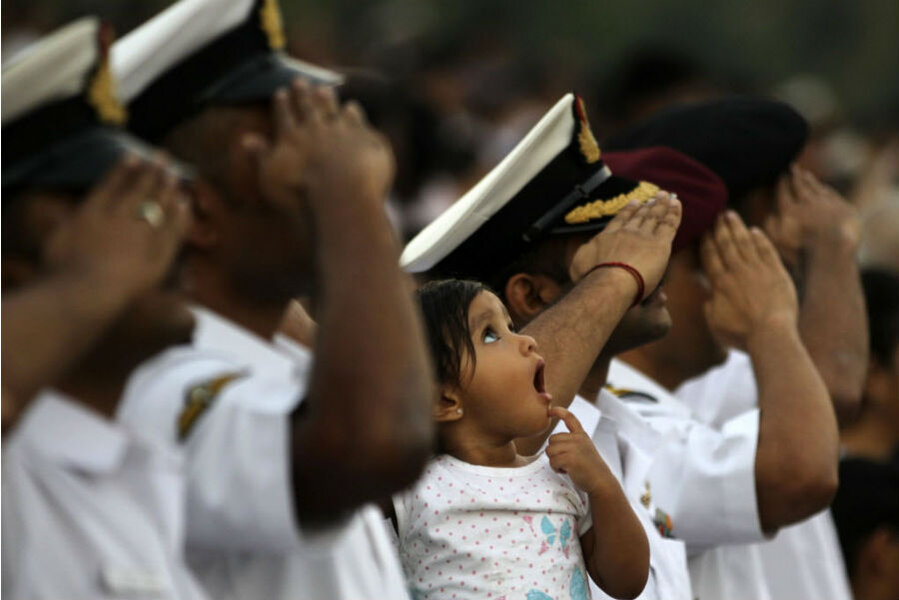India orders theaters to play national anthem before screenings
Loading...
India's highest court issued an order Wednesday that requires all movie theaters in the country to play the national anthem before every show, sparking both criticism and praise from Indian citizens.
The ruling comes as Indian Prime Minister Narendra Modi is attempting to unify the country against corruption amid the ongoing dispute over Kashmir and the fight against terrorism in the region. While the court's ruling caught many Indians by surprise, some analysts have noted a rise in aggressive patriotism in Indian media, in both entertainment and news outlets.
India's Supreme Court gave all movie theaters ten days to comply with the new order, which requires all theaters to play the national anthem while displaying an image of the Indian flag. The ruling also specified that audience members are "obliged to stand" for the duration of the piece, and prohibits the use of the national anthem outside the context of a standalone show of patriotism.
"There shall not be dramatization of the National Anthem and it should not be included as a part of any variety show," reads the court ruling. "When the National Anthem is sung or played it is imperative on the part of every one present to show due respect and honour. To think of a dramatized exhibition of the National Anthem is absolutely inconceivable."
The case that prompted the ruling, Shyam Narayan Chouksey v. Union of India, centers on a retired engineer who has devoted much of his retirement to lawsuits related to the flag, the national anthem, and environmental issues.
It all started 13 years ago, Mr. Chouskey says, he went to see "Kabhi Khushi Kabhi Gham," a popular Bollywood film in which a pivotal scene features the Indian national anthem, "Jana Gana Mana."
"When the national anthem was being played in the movie, I stood up. But I was the only person standing," said Chouskey, according to The Indian Express. "Those behind me said that I was obstructing their view – instead of standing up they asked me to sit down. It hurt me."
Chouskey went to court and managed to get the film banned, but that order was stayed. Since then, he has worked to ensure the anthem is treated with reverence, culminating in the current Supreme Court decision.
Until now, Chouskey himself was too obscure to make a blip on the national radar. But his style of patriotism has been growing more attractive to many Indians, particularly among higher-ups in government and the media.
"This sudden patriotic fervor largely stems from the jingoistic milieu that the present regime has fostered," says Sumit Ganguly, Tagore Chair in Indian Cultures and Civilizations and professor of political science at Indiana University, in an email to The Christian Science Monitor. "Of course a series of terrorist attacks which can be traced to India's long-standing adversary have not helped matters. As in any country, they have resulted in a 'rally around the flag' syndrome."
The prime minister has been working to unify the country, in an attempt to stem fiscal corruption and drum up support for the fight against militants in the region of Kashmir.
Some movie theaters already play the national anthem before each performance. The western state of Maharashtra, the center of the Bollywood movie industry, for instance, has long mandated the inclusion of the anthem. But for many residents of India's other 28 states, the new mandate seems excessive.
"There is widespread national regard for the national anthem," writes Professor Ganguly. "Consequently, the SC's decision make it mandatory to play it in movie theaters strikes me as being quite unnecessary and utterly baffling. Every child who has the good fortune of attending primary school in India can recite it by heart."
The anthem began and ended each school day, recalls Srinivasan Sitaraman, professor of political science at Clark University in an email to the Monitor. "We didn't have clocks in the classroom and neither did we have pocket watches, we simply followed the school bell and the ... anthem to mark our day at school."
The anthem featured prominently in public life, he writes, "played at all public occasions, school events, public meetings, sporting events, and movie halls. However, over the years this practice gave away to more secular practices and people were less inclined to engage in public displays of nationalism."








